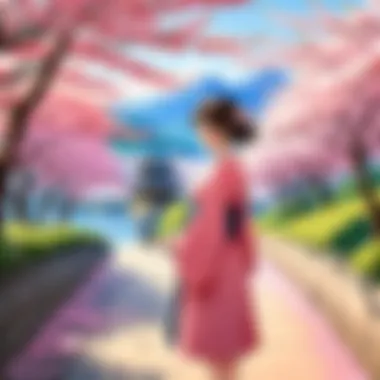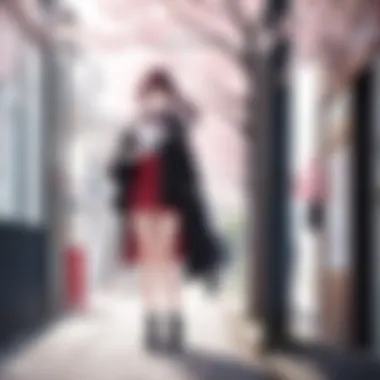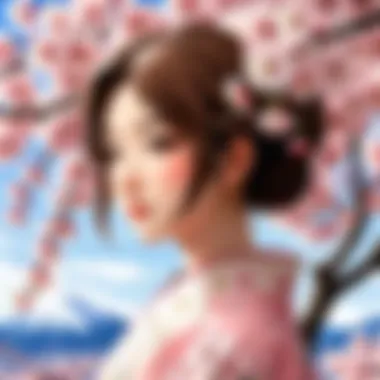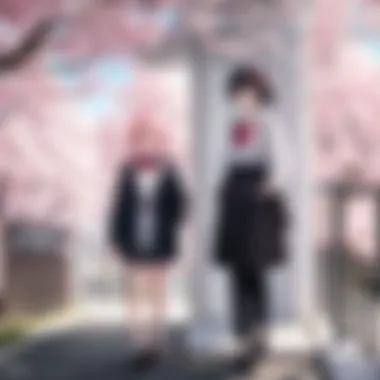Exploring Cherry Blossoms in Manga: Beauty in Bloom


Intro
Cherry blossoms, or sakura, hold a revered place within Japanese culture, symbolizing the transient beauty of life. This delicate flower also carries significant thematic weight in manga, where it often reflects emotions, narratives, and character journeys. The integration of cherry blossoms in manga extends beyond mere aesthetics; they serve to enhance storytelling by adding layers of meaning and cultural context. As creators leverage their visual appeal and cultural resonance, these blossoms have become a crucial element that shapes the dynamics of manga series.
This article will investigate how cherry blossoms impact various facets of manga, assessing their role in character development, narrative progression, and artistic expression. It will survey notable manga that prominently feature these blooms, offering insights into the intricate relationship between nature and storytelling. By combining cultural insights with artistic analysis, readers will gain a comprehensive understanding of the significance of cherry blossoms in the world of manga.
The Cultural Importance of Cherry Blossoms in Japan
Cherry blossoms are more than just beautiful flowers in Japan; they are a symbol of the nation's cultural heritage. The significance of these blossoms encompasses various aspects such as history, symbolism, and social practices. This deep-rooted connection makes them a prominent element in many manga narratives, enhancing themes and character arcs. Understanding the cultural importance of cherry blossoms is essential for appreciating their representation in manga.
Historical Significance
Cherry blossoms, or sakura, have a long-standing historical connection in Japan, dating back over a thousand years. Their presence was first noted during the Nara period, where the blooms were celebrated in poetry and art. The Heian period brought a greater appreciation for these flowers, establishing them as a marker of springtime beauty. The practice of hanami, or flower viewing, also began around this time.
Throughout history, cherry blossoms have been linked to various events and periods, reflecting the nation’s values and aesthetics. For example, during the Edo period, the widespread planting of cherry trees created spaces for public enjoyment and artistic representation. This tradition continues to flourish today, serving as a reminder of impermanence and beauty in life.
Symbolism in Japanese Culture
In Japanese culture, cherry blossoms symbolize numerous concepts, primarily the fleeting nature of life. This symbolism is influenced by the short-lived beauty of the blossoms, typically lasting for about a week to ten days. The blossoms prompt reflections on transience, which resonates deeply within Japanese philosophy.
Moreover, cherry blossoms are often associated with renewal, hope, and the promise of new beginnings. They are a metaphor for purity and the ideals of youth. In this context, their representation in manga often underscores character development and emotional growth, making them a powerful motif in storytelling.
Cherry Blossoms and Seasonal Celebrations
Seasonal celebrations centered around cherry blossoms are significant in Japanese culture. Hanami festivals occur each spring, drawing people together to appreciate the beauty of the blooms and foster community connections. Families, friends, and colleagues gather under blooming trees to enjoy picnics, share stories, and reflect on life.
These gatherings are not just about the blossoms; they are a celebration of renewal and hope within the community. In manga, these scenes often serve as pivotal moments where characters connect. The visual representation of cherry blossoms in these narratives aligns closely with shared experiences during hanami, effectively deepening reader engagement.
"The beauty of cherry blossoms embodies the essence of momentary happiness in life, symbolizing the blend of beauty and sorrow."
Cherry Blossoms in Manga: An Overview
Cherry blossoms, or sakura, hold a significant place in Japanese culture and art. In manga, their importance transcends mere decoration; they embody themes of beauty, transience, and cultural identity. This overview examines how cherry blossoms are woven into the fabric of manga storytelling, offering an understanding that enhances both narrative depth and visual appeal.
Thematic Representations
Thematic representations of cherry blossoms in manga often reflect deeper philosophical insights. Their fleeting nature symbolizes the transient quality of life. Many characters experience growth and change, paralleling the blossoms’ short bloom period. Additionally, sakura can be a metaphor for love and relationships. In many stories, key moments occur beneath cherry trees, emphasizing the emotional weight of these scenes. Writers incorporate concepts of seasonal change to mirror character journeys, enriching the reader's connection with the narrative.
Visual Elements and Artistry
Manga artists are skilled in using cherry blossoms as a visual device. The soft pink hues of sakura contrast sharply with the vivid colors of characters and backgrounds. This contrast creates a captivating aesthetic. Artists use cherry blossoms to guide the reader's eye within panels, drawing attention to significant moments. Furthermore, the delicate petal fall is depicted in various ways, contributing to the atmosphere. The alignment of characters with the blossoms also signifies their emotional and psychological states, creating layers of meaning in the artwork.


Cultural References in Storylines
Culturally, cherry blossoms reference significant events in Japanese history and traditions. In many plots, hanami, the custom of viewing cherry blossoms, serves as a backdrop for social interactions. This cultural practice conveys camaraderie, nostalgia, and reflections on the past. Additionally, many characters hail from settings where cherry blossoms dominate the landscape, grounding the narrative in a specific cultural context. Through these references, manga artists evoke a sense of place and community, allowing readers to engage with cultural nuances.
"Cherry blossoms in manga encapsulate the essence of life’s beauty and its inevitable impermanence, serving as a powerful narrative tool."
This focus on cherry blossoms provides readers with an enriched experience, making their role in manga far more significant than mere scenery. The exploration of these elements reveals the intersections of nature, art, and emotion, fostering a deeper appreciation for the medium.
Notable Manga Featuring Cherry Blossoms
Cherry blossoms hold a significant place in Japanese culture and their depiction within manga serves multiple purposes. This section will explore three notable manga series that prominently feature cherry blossoms, illustrating how these blooms enhance narrative depth, character development, and visual expression.
Sakura Hime: The Legend of Princess Sakura
Sakura Hime: The Legend of Princess Sakura intertwines Japanese folklore with the beauty of cherry blossoms. The story follows Princess Sakura, who becomes an emblem of purity and transformation. The cherry blossom represents not only the fleeting nature of beauty but also the strength of the protagonist. Each scene that contains cherry blossoms enhances the emotional weight of the narrative, emphasizing pivotal moments of growth and sacrifice. Moreover, the delicate details in the artistry, such as vibrant colors and soft lines, help to create an atmosphere that complements the ethereal nature of the cherry blossoms.
The use of cherry blossoms in this manga also reinforces the cultural significance of the flower within Japan. The connection between the character and these natural elements deepens readers’ engagement, allowing them to reflect on the themes of love, loss, and destiny.
Anohana: The Flower We Saw That Day
Anohana: The Flower We Saw That Day revolves around a group of childhood friends who are brought together by the ghost of their deceased friend, Menma. The series artfully employs cherry blossoms as a metaphor for the memories and emotions tied to their shared past. Visual symbolism is critical here: cherry blossoms often bloom in memory scenes, indicating moments of reflection and nostalgia. Their petal's transient nature mirrors the fleeting moments of life, making viewers contemplate the impermanence of relationships.
As the characters confront unresolved feelings, the cherry blossoms serve as a poignant reminder of what has been lost and the beauty that once was. The artistry, combined with the blossoms’ symbolism, enriches the storytelling, making it emotionally resonant for audiences.
Cardcaptor Sakura
Cardcaptor Sakura is a beloved series that showcases the journey of a young girl who must capture magical cards. Cherry blossoms often appear during critical transformations and new friendships in this manga. The presence of cherry blossoms in various scenes emphasizes the themes of growth and the enchanting nature of magic. In moments where Sakura faces challenges or celebrates achievements, the cherry blossoms can be seen swirling around her, encapsulating the change and wonder within her life.
Furthermore, the vibrant art style enhances the immersive experience, where translucent petals become a backdrop for her adventures. The playful yet heartfelt depiction of cherry blossoms signifies not only beauty but also the courage to embrace one’s destiny.
"Cherry blossoms serve as a powerful narrative device in manga, reflecting deeper meanings of life, love, and loss."
Character Dynamics and Cherry Blossoms
Cherry blossoms play a crucial role in the narrative and emotional development of characters within manga. Their presence transcends mere aesthetics; they offer a profound medium through which growth and transformation are explored. The delicate yet transient nature of cherry blossoms metaphorically parallels the realities of life, allowing for a more nuanced portrayal of character dynamics. As characters navigate their personal journeys, the blooming and falling of cherry blossoms reflect their emotional states, growth, and the inevitable passage of time.
Growth and Transformation
In many manga, cherry blossoms symbolize change and the possibility of new beginnings. Characters often experience significant personal evolution beneath cherry trees, especially during pivotal moments. For instance, as characters confront their fears or make important decisions, the blossoming trees serve as a backdrop illustrating their inner change. The act of watching the blossoms bloom and then fall can also evoke feelings of nostalgia and realization, urging characters towards growth. More than just a seasonal marker, cherry blossoms become a crucial symbol of the character's path through challenges and successes.
Relationships Under Blooming Cherry Trees


Cherry trees frequently serve as a romantic setting in manga, where characters often encounter one another during the cherry blossom season. These scenes, filled with the beauty of blooming flowers, create an atmosphere of intimacy and connection. The fleeting nature of the blossoms amplifies the emotions shared between characters, making moments beneath the trees more significant. Here, a confession of feelings or reconciliation often occurs, highlighting how blossoms can enhance relationship dynamics. Each petal that falls can represent a moment shared or lost, imbuing the narrative with deeper meaning.
The Role of Cherry Blossoms in Character Arcs
Cherry blossoms can signify the climax or resolution in a character's arc. Many plotlines utilize the seasonal bloom to mark turning points, such as the acceptance of loss or coming-of-age moments. They become a visual cue for readers, indicating shifts in the narrative and character maturity. This element also aligns with the cyclical nature of life, emphasizing that while characters may face endings, new beginnings follow, much like the annual blooming of cherry blossoms.
"Cherry blossoms remind us of life's beauty and its transient nature, encapsulating themes that resonate deeply with character development in manga."
In examining character dynamics alongside cherry blossoms, the narrative gains depth. Each storyline integrates the blossoms as more than just a visual element; it allows for reflection on universal themes of transformation, relationships, and the journey of life.
Artistic Techniques in Depicting Cherry Blossoms
Artistic techniques play a critical role in how cherry blossoms are represented in manga. These techniques not only enhance the visual appeal but also convey deeper meanings associated with the blossoms. Through careful manipulation of color, composition, and integration into layouts, manga artists create immersive experiences that resonate with readers. This section examines key elements of artistic techniques that contribute to the effective depiction of cherry blossoms in manga.
Color Symbolism in Cherry Blossom Depiction
Color often carries significant meaning in visual arts. In manga, cherry blossoms are frequently illustrated in soft pinks and whites, symbolizing beauty and fragility. The use of these pastel shades helps to evoke feelings of serenity and peace, aligning with the cultural perception of cherry blossoms as harbingers of spring and renewal.
The contrast of cherry blossom colors against darker backgrounds can also amplify their visual impact. For example, a bright blossom surrounded by somber hues can signify hope amidst darkness. This technique invites readers to reflect on the complexities of life and emotions, much like the fleeting nature of the blossoms themselves.
Key Points of Color Symbolism:
- Soft Colors: Pink and white symbolize beauty and transience.
- Contrast: Darker backgrounds highlight hope and resilience.
- Evocative Emotions: Colors evoke feelings of nostalgia and longing.
Composition and Perspective Techniques
The arrangement of elements within the panels is vital for storytelling in manga. When illustrating cherry blossoms, artists often utilize a dynamic composition to draw the reader’s eye. This can mean placing the blossoms off-center or using angles that provide depth. Such techniques stimulate visual interest and enhance the narrative structure.
Perspective techniques, such as foreshortening, can also bring a sense of movement to the blooms. Artists might depict branches stretching towards the readers, making the blossoms appear to extend beyond the page. This immersion allows readers appreciate the beauty of cherry blossoms not just as an aesthetic element but as an integral component of the storyline.
Composition Techniques Include:
- Dynamic Arrangements: Off-center placements create visual interest.
- Depth and Movement: Foreshortening enhances immersion.
Integrating Cherry Blossoms into Panel Layouts
Integrating cherry blossoms skillfully into the panel layouts enhances their visual storytelling. Effective use of space allows the blossoms to act as both a background element and a narrative device. For instance, a scene set beneath blooming cherry trees can frame pivotal character moments, linking the visual environment with emotional depth.
Additionally, the flow of panels can guide the reader’s eye along with the movement of petals or the progression of scenes. This technique effectively illustrates the transitory nature of cherry blossoms while also promoting a seamless reading experience.
Some common strategies for integrating cherry blossoms include:


- Framing Characters: Blossoms can frame characters to emphasize emotional moments.
- Guiding Flow: Petals can lead the reader's eye through the panels.
The careful depiction of cherry blossoms in manga exemplifies the intricate relationship between nature and narrative, enhancing the reader's connection to the story.
In summary, the techniques employed in depicting cherry blossoms significantly enrich the narrative and aesthetic qualities of manga. They serve as much more than mere decoration; they embody rich symbolic meanings and enhance storytelling through thoughtful artistic choices.
Cherry Blossoms as Metaphor
Cherry blossoms often serve as a powerful metaphor in manga, articulating concepts such as beauty, transience, and the interconnectedness of life. These flowers, with their fleeting bloom, mirror the human experience—highlighting how beauty exists even in impermanence. This section explores three specific facets of these metaphors: impermanence and beauty, the cycle of life, and social commentary through nature.
Impermanence and Beauty
The motif of cherry blossoms encapsulates the concept of mono no aware, a term denoting a sensitivity to the ephemeral nature of things. Cherry blossoms bloom for a short period, representing the fleeting moments of beauty that are always around people. This duality often reflects characters' struggles within their narratives.
For instance, in Sakura Hime: The Legend of Princess Sakura, the protagonist grapples with her identity and the transient relationships she forms. The cherry blossoms, blooming around her, underscore the beauty of her connections, although brief. They evoke reflection on past joys and sorrows, creating a backdrop that enhances the emotional weight of the story.
Cycle of Life in Manga Narratives
In many narratives, cherry blossoms symbolize the cycle of life, linking themes of growth, decay, and rebirth. This symbolism can be seen in works like Anohana: The Flower We Saw That Day. Here, cherry blossoms blossom each spring, paralleling the emotional journeys of the characters who navigate loss and remembrance.
As characters confront their past, the blossoms represent the inevitable cycle of life. This linkage serves not only to deepen character development but also enriches the reader's understanding of life's patterns. They reflect the idea that life is a series of cycles where loss is followed by renewal, much like the seasons.
Social Commentary Through Nature
Cherry blossoms also serve as a means for social commentary within manga. The beauty of cherry blossoms illuminates the stark contrasts present in societal issues. For example, in Cardcaptor Sakura, the vibrant cherry blossoms contrast with the darker aspects of the characters' lives, like personal struggles and societal expectations. This contrast invites readers to reflect on broader themes, urging them to think beyond the narrative.
The depiction of cherry blossoms can highlight societal values or criticize prevailing attitudes. By using nature as a backdrop, manga artists deftly introduce social critique, facilitating discussions about themes such as environmentalism, urbanization, or the loss of tradition. Such layers enrich the reading experience, providing multiple avenues for interpretation.
The interplay of cherry blossoms and the characters' lives in manga invites readers to consider deeper themes around beauty, life, and society.
In summary, cherry blossoms are more than just a visual motif in manga; they are symbols that encapsulate profound ideas about life and society. Their metaphoric significance enhances the narrative depth, urging readers to engage with the themes presented.
Epilogue: The Enduring Appeal of Cherry Blossoms in Manga
The theme of cherry blossoms in manga transcends mere aesthetics; it embodies a profound cultural narrative deeply rooted in Japanese tradition. As this article has explored, cherry blossoms play a vital role in both the visual and thematic fabric of manga. Their presence signifies more than just beauty; it connects to ideas of impermanence, growth, and emotional resonance. This significance enriches the reading experience for both casual readers and dedicated fans, enhancing their connection to the characters and stories.
Influence on Contemporary Works
Contemporary manga has embraced cherry blossoms as a versatile symbol that resonates with modern themes while maintaining ties to cultural heritage. Many artists utilize cherry blossoms to reinforce character development and to depict pivotal moments in stories. For instance, in works like Your Lie in April, cherry blossoms are pivotal to the emotional landscape, framing moments of joy and sorrow. The interplay of cherry blossoms with narrative arcs also promotes themes of nostalgia and the ephemeral nature of life.
In recent years, the infusion of cherry blossoms into genres such as fantasy and romance indicates their adaptability. Artists frequently incorporate them in varied settings, from urban backdrops to serene landscapes, while leveraging their aesthetic to evoke feelings of hope or reminiscence. This adaptability keeps cherry blossoms relevant in the ever-evolving manga landscape.
Legacy and Future Directions
Looking forward, the legacy of cherry blossoms in manga appears promising. As more manga creators explore their cultural significance, they can continue to expand on how these blossoms influence narrative devices and artistic approaches. New digital platforms also allow for innovative expressions of cherry blossoms, facilitating fresh perspectives.
Emerging artists are experimenting with techniques, integrating cherry blossoms within visual storytelling in unique ways. This progression will likely foster dialogue about environmental awareness and the preservation of nature, magnifying their metaphorical weight in future storylines. Furthermore, collaborations with other art forms and cultures may give way to hybrid genres that continue to highlight cherry blossoms, affirming their lasting appeal in manga.
The enduring charm of cherry blossoms symbolizes a beautiful, transient reality that resonates with the essence of human experience, making them an ever-present element in manga's rich tapestry.







